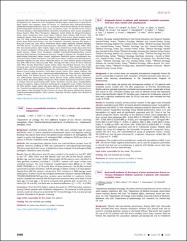Prognostic factors in patients with metastatic urothelial carcinoma who have been treated with atezolizumab

Göster/
Erişim
info:eu-repo/semantics/openAccessTarih
2020Yazar
Tural, DenizÖlmez, Ömer Fatih
Sümbül, Ahmet Taner
Özhan, Nail
Akar, Ebru
Çakar, Bilge
Köstek, Osman
Ekenel, Mahmut
Erman, Mustafa
Coşkun, Hasan Şenol
Selçukbiricik, Fatih
Keskin, Özge
Paksoy, Fatma
Oruç, Korkmaz
Bayram, Süleyman Nuri
Yılmaz, Uğur
Bilgetekin, İrem
Yıldız, Birol
Şendur, Mehmet Ali Nahit
Artaç, Macide
Üst veri
Tüm öğe kaydını gösterKünye
Tural, D., Ölmez, Ö. F., Sümbül, A. T., Özhan, N., Akar, E., Çakar, B. ... Artaç, M. (2020). Prognostic factors in patients with metastatic urothelial carcinoma who have been treated with atezolizumab. ESMO Virtual Congress içinde (S598-S598. ss.). Electrical Network, September 19-October 18, 2020. https://dx.doi.org/10.1016/j.annonc.2020.08.853Özet
Background: In the current study, we evaluated pretreatment prognostic factors foroverall survival (OS) in patients with metastatic urothelial carcinoma who have progressed after first-line chemotherapy in the Expanded-Access Program ofatezolizumab.Methods: In this study, we present the retrospective analysis of 113 patients withurothelial cancer treated with ATZ after progression on first-line chemotherapy.Eligible patients included metastatic urothelial carcinoma patients treated with at leastone course of ATZ. Univariate analysis was used to identify clinical and laboratoryfactors that significantly impact OS. Variables were retained for multivariate analysis ifthey had a statistical relationship with OS (P˂0.1) and were then included the finalmodel if P˂0.05.Results: In univariate analysis, primary tumour location in the upper tract, increasedabsolute neutrophil count (ANC), increased absolute lymphocyte count, neutrophil-tolymphocyte ratio (NLR)>3, liver metastases, baseline creatinine clearance (GFR) < 60ml/min, Eastern Cooperative Oncology Group (ECOG) performance status (1) andhemoglobin<10 mg/dl were all significantly associated with OS. Three of the fiveadverse prognostic factors according to the Bellmunt criteria were independent ofshort survival: liver metastases (HR¼ 0.323; 95% CI 0.174-0.60; P <0.001), ECOG PS1(HR¼ 0.459; 95% CI 0.236-0.895; p¼0.022), and haemoglobin level <10 mg/dl (HR¼0.373; 95% CI 0.217-0.642; P <0.001). In addition, NLR>3 (HR¼ 0.474; 95% CI 0.234-0.962; P ¼0.039) and GFR <60 ml/min (HR¼ 0.546; 95% CI 0.328-0.907; P ¼ 0.019),maintained a significant association with OS in multivariate analysis. Patients weredivided into three risk categories: the favourable risk group (0-1 prognostic factor;median OS¼20.1 mo.), the intermediate-risk group (2 prognostic factors; medianOS¼10.08 mo.) and the poor-risk group (3 prognostic risk groups; median OS¼ 2.2mo.) (log-rank P< 0.001).Conclusions: This model confirms the Bellmunt model with the addition of NLR>3 andGFR <60 ml/min. Taken together, these factors can be used for prognostic parametersin clinical trials that use immunotherapy in patients with bladder cancer who haveprogressed after first-line chemotherapy.
WoS Q Kategorisi
Q1Kaynak
ESMO Virtual CongressCilt
31Sayı
Supplement: 4Koleksiyonlar
- Bildiri Koleksiyonu [515]
- WoS İndeksli Yayınlar Koleksiyonu [6432]

















